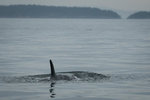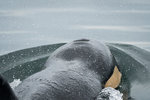

Plans are being laid to capture J50, the ailing young orca, as efforts to help her in the wild have failed and her condition continues to decline.
The National Oceanic and Atmospheric Administration (NOAA), which is in charge of recovery of the critically endangered population of southern resident killer whales, has been quietly laying plans for capture of the whale for weeks.
Orcas have strong family ties that endure for life. Separation of young orcas from their mothers and families was routine during the capture era in Washington state, when orcas, especially in J50’s family, were rounded up and taken to aquariums.
The youngest and smallest were targeted because they were the cheapest to ship. The piercing cries of orca parents as their young were taken away are well remembered by those who took part in the captures — including Jeff Foster, a member of a NOAA intervention team who used the agency said further intervention to help J50 will depend on avoiding harm to the rest of her family in J pod and the southern resident population. As long as she is with her family, the federal government won’t take her from their care, according to a news release from NOAA Tuesday night announcing the capture plans that are in the works. “Response teams” would only act to “rescue” J50 if she becomes stranded or separated from the rest of her family, “such that any risks of the intervention to the rest of her family are minimized,” the agency stated.
If veterinarians and others involved in assessing J50 in the field determine J50 cannot be treated or rehabilitated they would return her to J pod to spend the rest of her life with her family. “The overriding priority of any rescue intervention would be to evaluate, treat and rehabilitate J50 in a manner that would support the greatest chance of her survival while ensuring her return and reunification with her family as soon as possible so she can contribute to the long-term recovery of the population,” according to the agency’s press release.
The first public hearings on the controversial plan have been scheduled with just a few days’ notice: 7 p.m. Saturday at Friday Harbor High School in Friday Harbor, and 1 p.m. Sunday at the University of Washington Haggett Hall Cascade Room in Seattle.
Next steps for J50 could include everything from capturing her for a hands-on physical exam, including more diagnoses, treatment and return to the water — or even rehabilitation and care in captivity, with the goal of reuniting her with her family.
The objective, according to NOAA, is to protect her ability to grow up and reproduce — critical in a population of whales with only 75 members that has not had a successful pregnancy in three years. The most recent calf was born to Tahlequah, or J35. The female calf died after only one half-hour — but her mother clung to the carcass for at least 17 days, refusing to let it go as she swam more than 1,000 miles through the trans-boundary waters of the Salish Sea, raising worldwide concern.
She has become a symbol of the orcas’ peril due to human-caused pollution, underwater noise from vessels and recreational boats, and most of all, hunger. The southern residents are strictly fish eaters and depend in summer almost exclusively on chinook, another declining species. Both the whales and the fish they rely on are listed under the Endangered Species Act — and in the care of the same agency, NOAA, that has failed to return either the southern residents or the chinook in the Columbia and Snake Rivers or Puget Sound to health.
NOAA has captured and rehabilitated a live orca before: Springer, or A73, a northern-resident orca whale. However, that was a very different situation: She was an orphan, frequenting the Vashon ferry dock and in poor health. NOAA successfully rehabilitated her in a netted off cove before returning her to her family. She has since had two calves.
J50 is usually nestled with her family, though she does spend time alone; she is known for an independent streak. She also sometimes lately has been falling further behind her family as it travels throughout the Salish Sea.
That is when she would be most likely to be captured.
Some oppose the plan. Pia van Hanen of Seattle has already started a petition to stop the capture.
Ken Balcomb, of the Center for Whale Research, said he has refused to take part in any capture operation and that J50’s chances of recovery are slim. Even if she does survive, “she is a runt whale, she won’t ever grow up to reproduce,” he said.